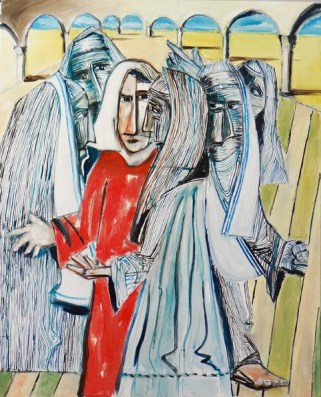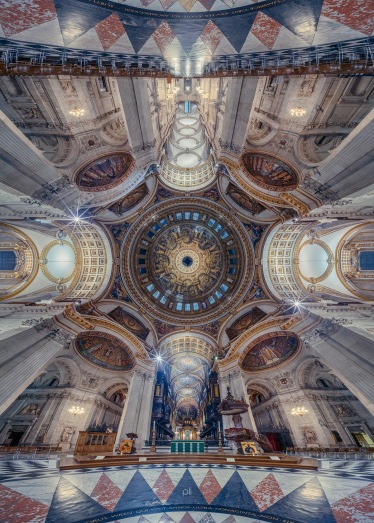
.
In Matthew 23:13-33 Jesus delivers 7 ‘woes’ to the scribes and Pharisees. My Bible (NASB) refers to 8 woes in its sub-title, but the woe in v. 14 is absent in the earliest manuscripts. 7 woes makes good sense. 7 is a symbol of fullness, or completeness. Matthew would like his readers to see these woes as full, complete, and impact-full. These woes then lead into Matthew 24, where Jesus teaches about the coming destruction of Jerusalem (70 A.D.).
A The first 2 woes involve other people (people are kept from entering the kingdom of God; a proselyte is turned into a ‘son of hell’), and end with a reference to Gehenna (~hell).
B The middle 3 woes call the scribes and Pharisees “blind guides” (2 times), “blind men” (2 times), and “blind” (once), and are highly chiastic.
A’ The last 2 woes refer to “tombs”, and end with a reference to Gehenna (~hell).
The third woe (vs 16-22) contains 3 chiasmi. It’s the only ‘woe’ which begins with “Woe to you, blind guides …” rather than “Woe to you, scribes and Pharisees, hypocrites …”. It’s a nice chiasmus. Its basic outline is: temple … altar … altar … temple (A B B’ A’). It contains 2 ‘smaller’ chiasmi within it – in A and B. I like the way the end builds from altar (B’) to temple (A’) to heaven (C). This ‘building’ at the end should be contrasted to the ‘diminishing’ of similar terms in the explanatory passage, Matthew 5:33-37:
33 “Again, you have heard that the ancients were told, ‘YOU SHALL NOT MAKE FALSE VOWS, BUT SHALL FULFILL YOUR VOWS TO THE LORD.’ 34 But I say to you, make no oath at all, either by heaven, for it is the throne of God, 35 or by the earth, for it is the footstool of His feet, or by Jerusalem, for it is THE CITY OF THE GREAT KING. 36 Nor shall you make an oath by your head, for you cannot make one hair white or black. 37 But let your statement be, ‘Yes, yes’ or ‘No, no’; anything beyond these is of evil.
Combining 5:33-37 with 23:20-22 you get a list that diminishes and then expands, with ‘heaven’ forming an inclusion (bookends): (diminishing:) heaven, earth, Jerusalem, ‘your head’ … (expanding:) altar, temple, heaven. Combined you get a lengthy list of things a person should not swear by. It is better to simply have your yes mean yes, and your no mean no (5:37). Jesus’ simplifies the topic.
To understand Jesus’ reference to the scribes and Pharisees as “blind guides”, see Matthew 15:14: “Let them alone; they are blind guides of the blind. And if a blind man guides a blind man, both will fall into a pit.” The references to blindness in the 3rd to 5th woes fittingly follow the first two woes, which refer to potential followers of the scribes and Pharisees. It’s fitting that the last 2 woes refer to tombs. Tombs refer to ‘the end’ (at least our end ;-), and in this case, ominously lead into Jesus’ prophecies concerning the destruction of Jerusalem and the temple.
Here are the 7 woes, with 6 chiasmi:
__________
13 “But woe to you, scribes and Pharisees, hypocrites, because you shut off the kingdom of heaven from people; for you do not enter in yourselves, nor do you allow those who are entering to go in.
[Verse 14 deleted]
15 “Woe to you, scribes and Pharisees, hypocrites, because you travel around on sea and land to make one proselyte; and when he becomes one, you make him twice as much a son of hell as yourselves.
16 “Woe to you, blind guides, who say,
A
a ‘Whoever swears by the temple, that is nothing;
b but whoever swears by the gold of the temple is obligated.’
c 17 You fools and blind men! Which is more important?
b’ the gold
a’ or the temple that sanctified the gold?
B
a 18 And, ‘Whoever swears by the altar, that is nothing,
b but whoever swears by the offering on it, he is obligated.’
c 19 You blind men! Which is more important?
b’ The offering,
a’ or the altar that sanctifies the offering?
—–
B’ 20 Therefore, whoever swears by the altar, swears both by the altar and by everything on it.
A’ 21 And whoever swears by the temple, swears both by the temple and by Him who dwells within it.
C 22 And whoever swears by heaven, swears both by the throne of God and by Him who sits upon it.
23 “Woe to you, scribes and Pharisees, hypocrites!
A For you tithe mint and dill and cummin,
B and have neglected the weightier provisions of the law: justice and mercy and faithfulness;
B’ but these are the things you should have done
A’ without neglecting the others.
24 You blind guides,
A who strain out
B a gnat
B’ and a camel
A’ swallow!
25 “Woe to you, scribes and Pharisees, hypocrites!
A For you clean the outside of the cup and of the dish,
B but inside they are full of robbery and self-indulgence.
C 26 You blind Pharisee,
B’ first clean the inside of the cup and of the dish,
A’ so that the outside of it may become clean also.
27 “Woe to you, scribes and Pharisees, hypocrites! For you are like whitewashed tombs which on the outside appear beautiful, but inside they are full of dead men’s bones and all uncleanness. 28 So you, too, outwardly appear righteous to men, but inwardly you are full of hypocrisy and lawlessness.
29 “Woe to you, scribes and Pharisees, hypocrites! For you build the tombs of the prophets and adorn the monuments of the righteous, 30 and say, ‘If we had been living in the days of our fathers, we would not have been partners with them in shedding the blood of the prophets.’ 31 So you testify against yourselves, that you are sons of those who murdered the prophets. 32 Fill up, then, the measure of the guilt of your fathers. 33 You serpents, you brood of vipers, how will you escape the sentence of hell?
34 “Therefore, behold, I am sending you prophets and wise men and scribes; some of them you will kill and crucify, and some of them you will scourge in your synagogues, and persecute from city to city, 35 so that upon you may fall the guilt of all the righteous blood shed on earth, from the blood of righteous Abel to the blood of Zechariah, the son of Berechiah, whom you murdered between the temple and the altar. 36 Truly I say to you, all these things will come upon this generation.”
37 “Jerusalem, Jerusalem, who kills the prophets and stones those who are sent to her! How often I wanted to gather your children together, the way a hen gathers her chicks under her wings, and you were unwilling. 38 Behold, your house is being left to you desolate!
39 “For I say to you, from now on you will not see Me until you say, ‘BLESSED IS HE WHO COMES IN THE NAME OF THE LORD!’”
24:1 Jesus came out from the temple and was going away when His disciples came up to point out the temple buildings to Him. 2 And He said to them, “Do you not see all these things? Truly I say to you, not one stone here will be left upon another, which will not be torn down.” … … …
Read Full Post »


